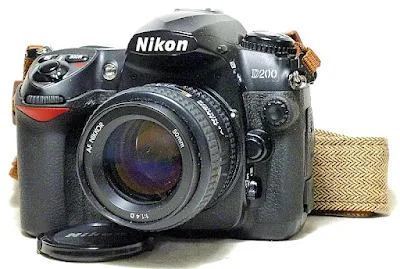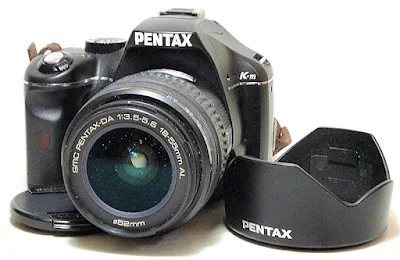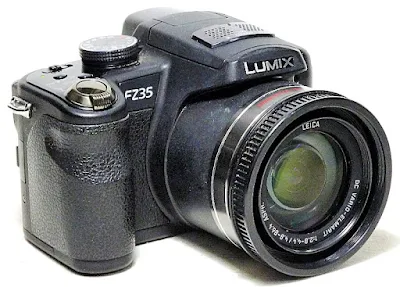I have been working on the 'Re-Living the CCD Sensor' concept for quite some time and have ended up collecting several CCD sensor cameras ranging from compacts and ultra-compacts to digital bridge cameras, and the ultimate prosumer digital SLR. These cameras are, of course, vintage, having been in production more than 10 years ago, with technology that is now considered redundant and bypassed.
CCD sensors were the standard for digital camera sensors from the early 80s till the late 2000s and were acknowledged for their higher-quality, low-noise images and better image homogeneity, with renderings that some say are more film-like. Now surpassed by the CMOS variety, CCD sensors are still used in areas of specialized application, such as Optical Microscopy, Space Photography, and Near-Infrared Imaging.
The selection here is never the best of what is available; it is just my wayward way of not picking up just any model camera I came across, but rather with the camera make that I am familiar with, and the model range of the series. You may be surprised that some of these cameras are still almost new, in complete working order, in complete kit sets, listed at the auctions at very low starting prices.
While digital cameras keep the balance down from the increasing cost of film and its associated development charges in film photography, digital cameras with CCD sensors will also keep the finances down with low-start cost, away from the more complex and probably equally hard to manage super digitals on the market today, with images and renderings that are equally nostalgic and worth their weight.
Nikon D200
My top pick is the Nikon D200, a 10.2MP CCD sensor vintage digital SLR camera, launched by Nikon in 2005, an upgrade to the previously introduced D100. A very robust build with a Magnesium alloy chassis, the D200 is more of a 'professional' model than the 'prosumer' label it was designated with. The camera bristles with features and functions enough to keep you occupied up the learning curve. The D200 can be used as well with AI manual focus and essentially all other Nikkor lenses manufactured from 1977 onward. The D200 is also fitted with an intervalometer for time-lapse photography.
Images with the CCD sensor are excellent, the body is compact with a true pro feel, power on is instant, very responsive with very short black-out time, very fast media write, excellent five frames per second continuous shooting, fast 'smart buffering,' fast and accurate eleven-point AF system... the list just goes on and on.
Pentax K-m (K2000)
An equally rewarding pick is the compact and full-featured Pentax K-m (K200 in the US), an entry-level model digital SLR camera fitted with an APS-C sensor and a KAF2 lens mount, launched by Pentax in 2008. The K-m is powered by a set of either 4 AA Lithium, Ni-MH Rechargeable, or Alkaline batteries. The camera was also designed to be adaptable to the plastic mount Pentax DA-L-series lightweight kit lenses, designed for KAF2-mounted Pentax digital cameras with APS-C sensors.
Exposure modes on the K-m include the familiar P (Program AE), Sv (Sensitivity Priority), Tv (Shutter Priority), Av (Aperture Priority), and Manual, complemented with automated selections for Auto Picture, Portrait, Landscape, Macro, Moving Object, Night Scene Portrait, and Flash Off.
Panasonic Lumix DMC-FZ40/FZ45
The Panasonic Lumix DMC-FZ40/FZ45, launched in 2011, an update of the FZ38/35 left off, features the same 24x optical zoom 25-600mm equivalent lens as the FZ100, but with a 14.1MP CCD sensor and simpler 230K dot 3.0 inch fixed LCD (as opposed to the FZ100's CMOS sensor and high-res screen). The FZ40 also offers AVCHD Lite 720p HD video recording, manual shooting modes, and Panasonic’s Sonic Speed auto-focus system, which comes with the industry's fastest focus times.
The Record/Playback slider on the top right shoulder of the previous version has been replaced with the Main Dial with a push and turn button action to activate and adjust Exposure Compensation, Shutter Speed, and Lens Aperture while using the PASM exposure modes. On Power up, the lens will now return to the zoom setting before the camera was shut down, and Playback is now a Green arrowhead on the camera back.
Panasonic Lumix DMC-FZ35/FZ38
The Panasonic Lumix DMC-FZ35/38, introduced by Panasonic in 2009, is a 12.1MP CCD sensor superzoom bridge digital camera with a 1:2.8~4.4 18X optical zoom 27mm Leica DC Vario-Elmarit wide-angle lens (for a full-frame equivalent range of 27-486mm), 201,000 pixels in-line Electronic Viewfinder (EVF) with dioptre adjustment, and a 2.7-inch 230,000 pixels live view TFT LCD. The camera, an update of the FZ28, was among the first to feature AVCHD lite format HD video recording.
Still appearing with the same SLR-like styling, the DMC-FZ35 has an additional Record/Playback slider on the top right shoulder of the camera back. This enables the playback screen to be activated even when shooting with the EVF. Likewise, the FZ35 supports both JPEG and raw file captures, comes with a shutter speed range from 60 seconds to 1/2000th second, Power O.I.S image stabilizer, a faster Venus Engine HD processor, and a Quick AF system twice as fast as that of the predecessor.
Panasonic Lumix DMC-FZ28
The Lumix DMC-FZ28, launched in 2009, was the update to the DMC-FZ18 (2008) and comes with a 10MP CCD sensor and a newer high-speed and high-performance Venus Engine IV image processor. The camera has a 1:2.8~4.4 27mm Leica DC Vario-Elmarit wide-angle lens with an 18X optical zoom for a full-frame equivalent range of 27-486 mm and features intelligent scene detection, 15x face recognition, intelligence ISO, intelligent exposure, and a macro mode that allows image capture at 1 centimeter.
The in-line EVF (Electronic Viewfinder) of the FZ28 is a 201,600-dot equivalent unit, while the LCD screen is a 2.7-inch unit with a 230,000-dot resolution. A new AF Tracking function automatically tracks the subject (once set) even if the subject moves around. Face detection accuracy has also been increased with this update, and the Intelligent Exposure function helps capture natural-looking, true-to-life images by suppressing blocked shadows and blown highlights.
Kodax PixPro AZ251
The Kodak PixPro AZ251, an entry-level 25x superzoom bridge camera with a 16MP CCD sensor, has optical image stabilization and comes with a 3-inch 230k rear LCD screen, 720p HD video recording, full auto as well as PSAM modes, panorama, HDR, and several scene modes and digital filters for more creative control. The AZ251 (with the AZ abbreviated from 'Astro Zoom'), was manufactured under license by JK Imaging. The camera was launched in 2013 as an update to the Kodak PixPro series, which started with the PixPro AZ651.
The camera is powered by a set of easily available 4x AA (Ni-MH or Alkaline) batteries, with the Alkaline rated for up to 280 shots according to CIPA test results. Connectivity to the computer is via a run-of-the-mill USB cable, the most convenient I have seen so far. A bit of a disappointment is that the AZ251 is not fitted with an EVF (Electronic Viewfinder), which is quite common among digital bridge cameras.
Olympus VR 370
The Olympus VR 370, from the compact travel zoom VR range, comes with a 16MP CCD sensor, TruePic III+ Image Processor, 12.5X optical zoom lens with a 35mm equivalent of 24-300mm lens, built-in flash, easy-to-use zoom, easy access menu control, ergonomic grip design, dedicated one-touch video button, 3.0-inch LCD with 460k-dot resolution, and Dual Image Stabilization for sharper images in dim light and when shooting at long telephoto focal lengths.
Launched in 2013, the VR 370 also features Face Detection, Dual Image Stabilisation, Magic Filter Movie and/or Stills, iAuto and AF Tracking, Beauty Mode, Scene Modes, Eye-Fi Card compatibility, Metal body, and USB-Battery Charge connectivity. Menus are logical and well laid out, easily accessible via a panel down the right-hand side of the screen, which you can adjust using the D-pad.
Olympus VR 350
The Olympus VR 350, launched in 2012, is a compact travel zoom with a 16MP CCD sensor, an Olympus 1:3~5.7 4.2-42mm (24-240mm full frame equivalent) 10x optical zoom lens, and a 3-inch 460,000 dot LCD screen. Much like the VR-370, built-in flash, easy-to-use zoom, easy access menu control, ergonomic grip design, dedicated one-touch video button, 3.0-inch LCD with 460k-dot resolution, and Dual Image Stabilization for sharper images in dim light and shooting at long telephoto focal lengths.
The VR 350 also comes with Face Detection, Dual Image Stabilisation, Magic Filter Movie and/or Stills, iAuto and AF Tracking, Beauty Mode, Scene Modes, Eye-Fi Card compatibility, Metal body, and USB-Battery Charge connectivity. Menus are logical and well laid out, easily accessible via a panel down the right-hand side of the screen, which you can adjust using the D-pad.
Olympus VR 330
The Olympus VR 330, a 14MP compact travel zoom with a small CCD sensor, was launched by Olympus in 2011. The camera comes fitted with a 12.5 optical zoom Olympus-made 24-300mm F3.0~5.9 equivalent zoom lens and has features that include 720p HD recording, image stabilization, Olympus's Magic filters, an HD output, and a 3.0-inch fixed-type LCD display. Connectivity options include USB 2.0 High-Speed data, composite standard definition video output, and Type-D Mini HDMI high-definition video output.
The Menu System of the VR 330, selectable from the LCD display, lists an additional 4 exposure modes (Scene, Magic, Panorama, and 3D) selection aside from the Program Auto and IAuto (Intelligent Auto) mode which can automatically select the correct mode from a subset of either Portrait, Landscape, Night + Portrait, Macro, or Sports, accessible down the right-hand side of the screen, which you can adjust using the D-pad.
Panasonic Lumix DMC-S5
The ultra-compact Panasonic Lumix DMC-S5, introduced in 2012, is part of the Lumix DMC-S series which includes the DMC-S1 (2011), DMC-S3 (2011), and DMC-S2 (2012), comes with a 16MO CCD image sensor, a 6 elements in 5 groups 28mm wide-angle Lumix DC Vario lens with 4x optical zoom (35mm camera equivalent: 28-112mm) lens with 3 aspherical lenses with 5 aspherical surfaces, acknowledged as an advanced lens with exceptional optical performance.
The camera features a true optical image stabilization system, comes with the Panasonic Venus Engine image processor, shoots full-resolution images at 1.4 frames per second, has a 2.7-inch 230,000 dot resolution LCD display, and a 23-point multi-area autofocus system which also includes a single-point focusing mode, and face detection. ISO sensitivity is rated from 100 to 1,600, expandable to 6,400 in High Sensitivity mode. Shutter speeds are from 8 seconds to 1/1,600 seconds.
Note: The masthead image was shot on a Lumix DMC-FZ18.

































No comments:
Post a Comment